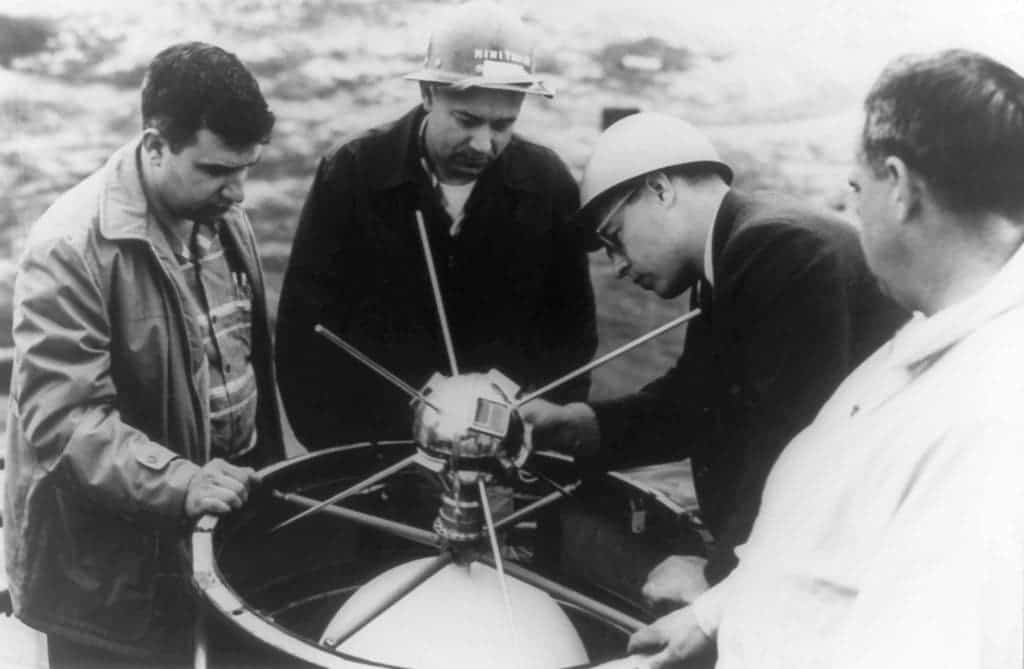The solar-powered Vanguard 1, the world’s first scientific satellite, is still in orbit and will remain there for centuries, experts say.

The flight backup for the Vanguard 1 satellite at Dulles International Airport, Chantilly, Virginia, USA. Image in Public Domain.
When the USSR launched Sputnik 1 sixty years ago, it sent ripples around the world. The Soviets surprised the world by putting the first artificial Earth satellite into orbit, but Sputnik didn’t do that much. It broadcasted on two separate frequencies (20.005 and 40.002 MHz), allowing amateur astronomers to observe its signal from Earth. Yet after 21 days, its battery ran out, and three months after its launch, it reentered the atmosphere. Sputnik 1 was a resounding success, but most importantly, it paved the way for greater things.
Vanguard 1 was mankind’s fourth satellite, and the first one to be solar-powered. Conceived by the Naval Research Laboratory (NRL) in 1955, Vanguard 1 was designed to test the launch capabilities of a three-stage launch vehicle as a part of Project Vanguard, and the effects of the environment on a satellite and its systems in Earth’s orbit. Vanguard 1 also offered geodetic measurements through orbit analysis and indirectly, it allowed researchers to determine the total electron content between the satellite and ground stations. All in all, the US was miles ahead of the Soviets, despite they were surprised by the sneaky Sputnik.
“It wasn’t a space race,” says NRL Historian, Angelina Callahan. “The US was always forthright in terms of launch and intended purposes for the satellite but the Soviets held their cards closer to their chest.”
“A lot of the disappointment of Sputnik [for the US satellite team] was from the fact that their partners in this international partnership were not telling them they were sending a satellite up,” says Callahan.
But while the entire planet might have been caught off-guard, the CIA wasn’t. To mark the 60 years anniversary of Sputnik 1, the agency declassified 59 memos, reports and summaries. These released documents show that the CIA not only wasn’t surprised but was actually expecting Sputnik to happen. They just underestimated how strong the propaganda effect would actually be.
“U.S. intelligence, the military and the administration of President Dwight D. Eisenhower not only were fully informed of Soviet planning to launch an earth satellite but also knew a Soviet satellite would probably achieve orbit no later than the end of 1957,” the C.I.A. said in a report released on Wednesday.
Still, for the general population, it was a shock. It added fuel to an already burning fire and greatly accelerated the US space program, leading to a turn of events which would eventually send man on the Moon. But before Neil Armstrong walked on the Moon, they still had to send a satellite into orbit, and scientists had a rocky road ahead.

A team of Vanguard I scientists mount the satellite in the rocket. Credits: Naval Research Laboratory.
In December 1957, just months after Sputnik, the US were carrying out a test for the Vanguard project. While the Soviets were secretive about their project, the world’s media gathered at Cape Canaveral, Florida for the US launch. It turned out to be a less than inspired idea. All eyes were on the launchpad as the rocket took off. The time was 11:44.559 a.m. Two seconds later, a scream escaped someone in the blockhouse control room: “Look out! Oh God, no!” Propulsion-expert Kurt Stehling, who was overseeing the launch, described the crash “as if the gates of Hell had opened up.” It was a humiliating moment for the US. Newspapers were abuzz with titles featuring “flopnik”, “kaputnik” and “stayputnik”.
But it was also very unfair. All space projects have a lot of failures — the Soviets did too — it was just that the entire world got to witness this one. That year, the Americans lost the propaganda battle, but they weren’t doing so bad in the science war. Working with ex-Nazi rocket pioneer Wernher von Braun, it didn’t take long for the US to send its first satellite into orbit. Explorer 1 launched just three months after the resounding “flopnik” crash, and after another month, Vanguard 1 also went to orbit.
Vanguard 1 sent valuable data back to Earth until 1964 when communication was lost. But according to space debris analyst Tim Flohrer, Vanguard 1 is still in orbit and will likely remain there for “several hundred, if not a thousand years.” That may not take the headlines like Sputnik did, but it’s just as noteworthy — if not more.









